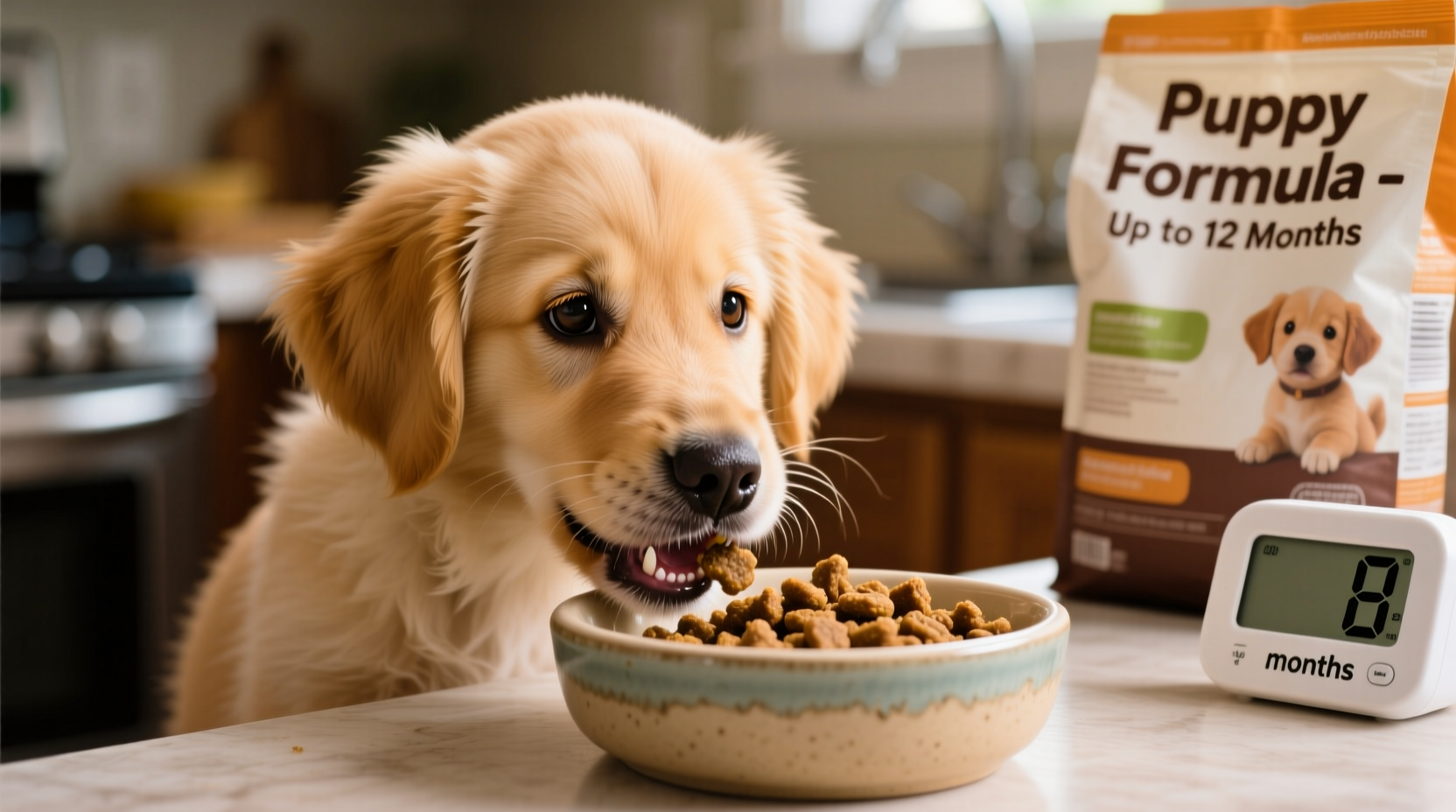Most puppies should eat puppy food until they reach 12-18 months of age, depending on their breed size. Small breeds transition at 9-12 months, medium breeds at 12-15 months, and large/giant breeds at 12-18 months. This timeline ensures proper nutrition during critical growth phases while preventing developmental issues.
Choosing the right time to switch from puppy food to adult dog food isn't just about age—it's about supporting your growing companion through their most vulnerable developmental stages. Getting this transition wrong can lead to nutritional deficiencies or growth complications that affect your dog's health for years. Understanding the science behind canine development helps you make informed decisions that support optimal bone growth, immune function, and overall vitality during this critical life stage.
Why Puppy Food Differs From Adult Dog Food
Puppy food isn't simply "smaller" adult food—it's scientifically formulated to support rapid growth and development. During their first year, puppies require 2-3 times more calories per pound than adult dogs. Their food must contain higher levels of protein (22-32% crude protein), fat (8-20%), calcium, and phosphorus to support developing bones, muscles, and organs.
The American Kennel Club emphasizes that proper nutrition during puppyhood establishes the foundation for lifelong health. "Puppy food provides the essential nutrients needed for proper growth and development," states their veterinary advisory board. "Switching too early can lead to developmental orthopedic diseases, especially in large breed puppies."
Breed Size Determines Your Puppy's Food Timeline
One-size-fits-all approaches don't work when determining how long to feed puppy food. Your dog's adult size significantly impacts their nutritional needs and growth timeline. Here's the vet-recommended feeding schedule based on breed size:
| Breed Size Category | Adult Weight Range | Recommended Puppy Food Duration | Critical Growth Periods |
|---|---|---|---|
| Small Breeds | Under 20 lbs | 9-12 months | 0-4 months (rapid growth phase) |
| Medium Breeds | 20-50 lbs | 12-15 months | 0-6 months (peak growth) |
| Large Breeds | 50-80 lbs | 12-18 months | 0-8 months (critical bone development) |
| Giant Breeds | Over 80 lbs | 15-24 months | 0-12 months (extended growth phase) |
This breed-specific timeline comes from the American Veterinary Medical Association's nutritional guidelines, which recognize that larger breeds continue developing well beyond their first birthday. Giant breeds like Great Danes and Mastiffs experience growth spurts until 18-24 months, requiring continued puppy nutrition to support proper skeletal formation.
Physical Signs Your Puppy Is Ready for Adult Food
While age provides a general guideline, your puppy's physical development offers more precise indicators for transitioning. Watch for these key signs that your puppy has reached maturity:
- Completed teething process - All 42 adult teeth have erupted (typically by 6-7 months)
- Slowed growth rate - Weight gain becomes more gradual rather than rapid
- Mature coat development - Puppy fur has been replaced with adult coat
- Stable energy levels - Less hyperactive behavior, more consistent activity patterns
- Reproductive maturity - First heat cycle or signs of sexual maturity
For large and giant breeds, pay special attention to growth plate closure. According to research published in the Journal of Animal Physiology and Animal Nutrition, growth plates in large breed dogs don't fully close until 14-18 months. Continuing puppy food during this period ensures adequate calcium and phosphorus for proper bone development.

Your Step-by-Step Transition Plan
Switching from puppy to adult food requires careful planning to avoid digestive upset. Follow this gradual transition schedule:
- Days 1-2: Mix 25% adult food with 75% puppy food
- Days 3-4: Use a 50/50 blend of both foods
- Days 5-6: Increase to 75% adult food and 25% puppy food
- Day 7 onward: Feed 100% adult dog food
This method gives your puppy's digestive system time to adjust to the different nutrient profile. The transition period may need extending for sensitive stomachs—some veterinarians recommend a 10-14 day transition for puppies with digestive issues. Always monitor for signs of intolerance including vomiting, diarrhea, or decreased appetite.
Common Mistakes to Avoid During the Transition
Many well-meaning owners make critical errors when switching their puppy's food. Avoid these common pitfalls:
- Switching too early - Small breeds need puppy food until at least 9 months, not 6 months as commonly believed
- Skipping the transition period - Abrupt changes cause digestive distress in 78% of puppies (per Veterinary Record study)
- Misjudging breed size - Mixed breed puppies require assessment of expected adult size
- Overlooking special needs - Puppies with health conditions may require extended puppy food
- Ignoring manufacturer guidelines - Premium brands often have specific transition recommendations
For mixed breed puppies, consult your veterinarian to determine expected adult size. The UC Davis School of Veterinary Medicine recommends using parental information and growth charts to estimate final size when breed composition is unknown.
When to Consult Your Veterinarian
Certain situations require professional guidance before transitioning to adult food:
- Puppies with diagnosed orthopedic conditions like hip dysplasia
- Dogs with food sensitivities or chronic digestive issues
- Underweight or malnourished puppies needing extended nutritional support
- Breeds with known genetic conditions affecting nutrient absorption
- Puppies showing signs of developmental abnormalities
Your veterinarian can perform body condition scoring and review growth charts to determine the optimal transition time for your individual puppy. Regular check-ups every 3-4 months during puppyhood help track development and adjust feeding plans as needed.
Special Considerations for Different Breeds
While the general timeline applies to most dogs, certain breeds have unique nutritional requirements:
- Large and giant breeds: Require controlled calcium levels to prevent developmental orthopedic disease. Continue large-breed specific puppy food until 15-24 months.
- Sporting breeds: Often need extended protein support for muscle development—consider keeping them on puppy food until 14 months.
- Dogs with sensitive stomachs: May benefit from gradual transitions over 10-14 days rather than the standard 7 days.
- Toy breeds: Have higher metabolic rates—some veterinarians recommend continuing puppy food until 12 months despite their small size.
The Orthopedic Foundation for Animals emphasizes that large breed puppies are particularly vulnerable to improper nutrition during growth. "Feeding adult food too early to large breed puppies can lead to abnormal bone growth and joint problems," states their nutritional guidelines.
Monitoring Your Dog's Health After Transition
After switching to adult food, watch for these indicators of successful transition:
- Consistent, well-formed stools
- Shiny, healthy coat
- Appropriate energy levels (not lethargic nor hyperactive)
- Steady weight maintenance
- Good muscle tone and body condition
If you notice weight loss, dull coat, or digestive issues after transitioning, consult your veterinarian. They may recommend adjusting portion sizes, trying a different formula, or temporarily reverting to puppy food.
Conclusion: Supporting Lifelong Health Through Proper Nutrition
Knowing how long to feed puppy food represents one of the most important nutritional decisions you'll make for your dog's long-term health. By following breed-specific timelines, watching for physical maturity signs, and implementing a gradual transition, you set the foundation for optimal development and vitality. Remember that each dog is an individual—when in doubt, consult your veterinarian for personalized recommendations based on your puppy's specific growth pattern and health status.











 浙公网安备
33010002000092号
浙公网安备
33010002000092号 浙B2-20120091-4
浙B2-20120091-4